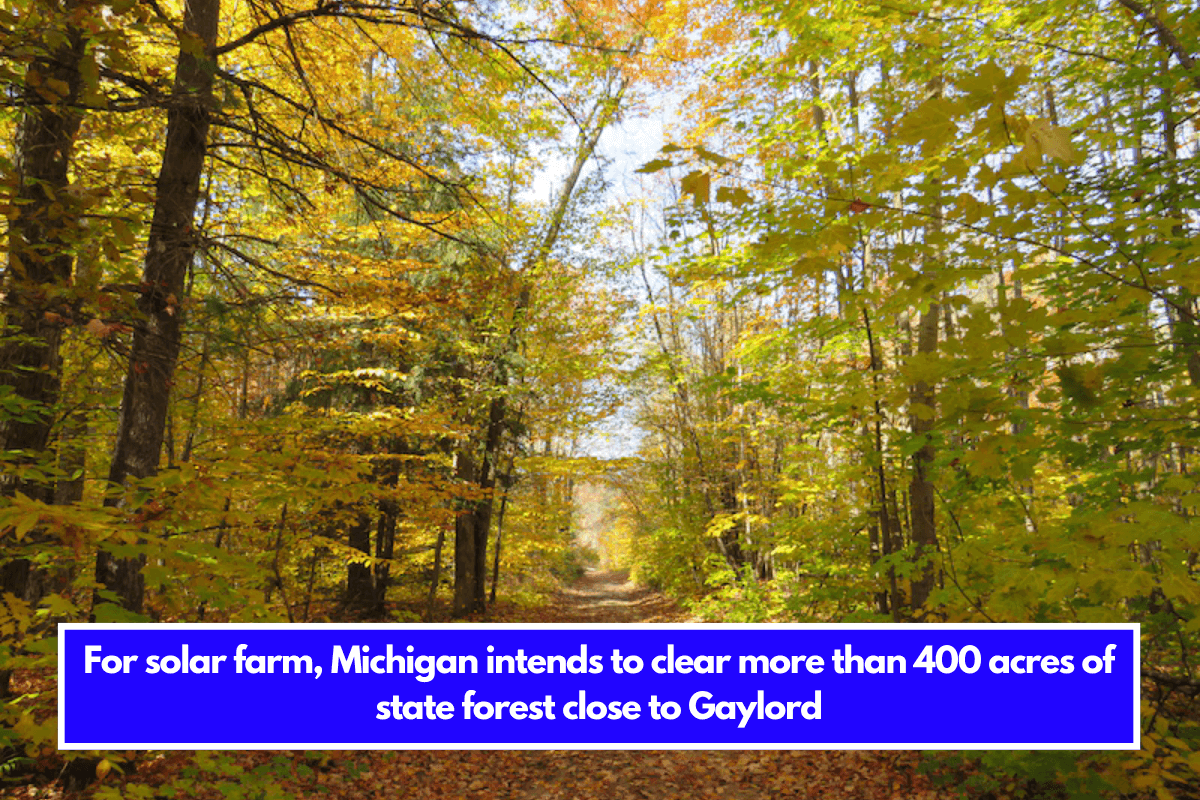Gaylord, Michigan – A 420-acre swath of state forestland near Gaylord will be cleared for a solar farm under a lease agreement with the Michigan Department of Natural Resources, according to a senior state official.
The DNR recently assessed 1,200 acres of public trust land in Otsego County near a major power transmission line to determine its suitability for solar arrays. Agency leaders ultimately decided to lease 35% of that land to complement other nearby solar projects that were already in the works.
This comes as the DNR’s hunting and fishing license revenues are dwindling, and Michigan is falling behind in building enough renewable energy to risk failing to meet a key state climate goal of 100% clean energy by 2040.
The DNR intends to address both issues by leasing 4,000 acres of public land across the state in the coming years. Officials said the state solar initiative could begin just west of Gaylord.
Forest for the trees
According to Scott Whitcomb, DNR director of public lands, a public notice advertising competitive bidding for solar proposals on 420 acres of state land in Otsego County’s Hayes Township will be published in the Gaylord newspaper and on the DNR website in the coming days.
He stated that if local governments and a sufficient number of residents request it, the DNR will hold a public hearing.
On October 21, 2024, MLive filed a Freedom of Information Act request for documents and digital files related to the project, which is still pending.
According to Whitcomb, state officials are aware that their decision will be criticized.
“It is not particularly popular with everyone. I will be honest about that.”
Recently, scientific research has focused on deforesting land for renewable energy. According to evidence from Harvard University and Chinese researchers, the loss of carbon-dioxide-consuming forests for solar installations results in a net increase in greenhouse gas emissions – the air pollution that fuels the accelerating climate crisis.
That means that clearcutting forests is counterproductive to the climate fight, even for renewable energy sources that do not emit greenhouse gases into the atmosphere. That’s simply how effective forests are at converting carbon dioxide into oxygen via natural photosynthesis.
Some of the acreage in question near Gaylord was previously cleared and replanted with red pine seedlings, a popular timber species. Other areas remain forested and have oil and gas wellheads.
However, the nearby high-voltage transmission line remains the most important factor on the site.
Whitcomb said that expanding a planned 200-megawatt solar farm on adjacent private land by 420 acres of “less than pristine” public land bisected by an existing major powerline would reduce the need for additional connecting powerlines.
He argued that infrastructure logistics for this tract of state forestland may not be available on other, more altered land elsewhere.
“You could have a degraded site and it’s not close to an interconnect, or if it’s close to an interconnect, it might not be in a place where the grid can take the electrons,” says Whitcomb.
He stated that the DNR had to decide whether to lose this specific forest at the 45th Parallel in rural Otsego County.
“I would rather make the development a little bigger here and avoid creating a new development elsewhere that has those same impacts,” he told reporters.
The issue is that in the section about protecting Michigan’s land and water, the Michigan Healthy Climate Plan specifically states to “avoid land-use conversion that causes a net increase in (greenhouse gas) emissions and prioritize land uses that reduce (greenhouse gas) emissions”.
Whitcomb stated that he hopes to resolve the conflict by using a portion of any future DNR solar leasing revenues to purchase additional land that may be more beneficial for wildlife habitat connectivity, public access needs, and carbon sequestration.
However, that is not the plan for the entire expected solar leasing revenue.
“We don’t give away this land for free,” Whitcomb explained. “That lease revenue can be used for natural resource management. So, while it isn’t the only reason, it is one we consider. The bottom line is that we must fund this agency’s activities in some way.”



















Solar? Really? An unreliable source of energy. Give me a break. From the party of Eco-maniacs. How about more useless windmills destroying or countryside?